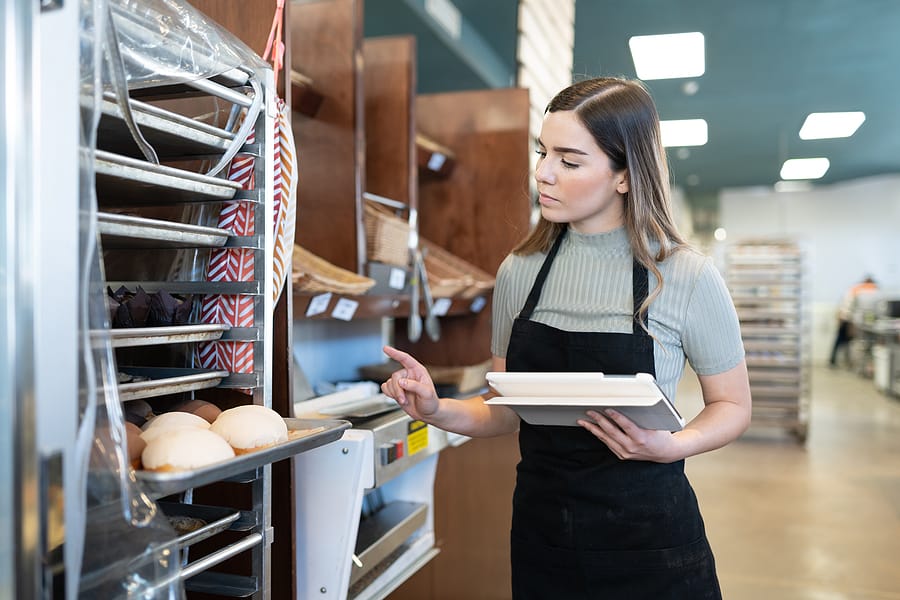Restaurant Inventory Management (Complete Guide & Template)
Successful restaurant management calls for outstanding food, outstanding service, and efficient and effective inventory control. An effective inventory management system is essential for cutting waste, increasing efficiency, and ensuring a restaurant runs smoothly. Restaurant owners and managers must have a firm grasp of restaurant inventory management principles and procedures, given the dynamic nature of the food sector.
This post explores tactics, best practices, and technological advancements that could alter how restaurants track, manage, and improve their inventory. Best restaurant inventory management practices help restaurants in maximizing profits, reducing food cost, enhancing sustainability, and increasing general efficiency. This includes everything from ingredient sourcing to stock level control and spoiling minimization.
Among the many facets of inventory management are precise stock tracking, demand forecasting, calculating food cost percentage, ingredient consumption monitoring, and matching inventory levels to sales trends. A careful balance must be struck between ensuring enough supplies for a seamless client experience and avoiding overstocking, which can result in waste or tied-up capital.
What is Restaurant Inventory Management?
Restaurant inventory management refers to tracking, controlling, and optimizing the inventory of ingredients, supplies, and other items within a restaurant. It involves monitoring stock levels, managing procurement, and ensuring the availability of necessary items to support the restaurant’s operations.
Several essential elements go into effective restaurant inventory management, including:
- Inventory tracking: Tracking the restaurant’s inventory requires precisely registering and keeping track of the amounts of ingredients, drinks, utensils, equipment, and other products. It requires routinely updating both perishable and non-perishable item inventories.
- Procurement and purchasing: Managing the procurement process, which entails finding suppliers, negotiating contracts, and placing orders for necessary commodities, is a component of restaurant inventory management. It seeks to guarantee prompt delivery of excellent goods at reasonable costs.
- Stock control and rotation: Restaurants must effectively manage and rotate their stock to reduce waste and preserve freshness. This entails using FIFO inventory rotation techniques, structuring storage spaces, and marking products with expiration dates.
- Demand forecasting: Restaurants can improve their inventory levels by anticipating consumer demand and predicting sales. Restaurants can lessen the risk of shortages and overstocking by making informed judgments about the quantity of goods and supplies needed by studying historical data, seasonality, and market trends.
- Supplier management : Building trusting connections with dependable suppliers is essential for effective inventory management. A constant restaurant supply chain can be kept maintained by creating clear communication lines, keeping an eye on product quality, and negotiating advantageous conditions.
- Technology and automation: Using specialist restaurant management systems or restaurant inventory software helps automate and expedite inventory processes. Real-time inventory tracking, report generation, purchase order management, and reliable data analysis can all be facilitated by these solutions.
- Waste reduction and cost optimization: Waste minimization, food spoilage reduction, and cost reduction are the goals of efficient inventory management. This entails putting portion control mechanisms in place, keeping an eye on consumption trends, and figuring out where waste may be reduced through precise inventory management.
Why is inventory management important for restaurants?
Inventory management is crucial for restaurants and should be included on every restaurant opening checklist due to the following reasons:
- Effective inventory management: This enables restaurants to manage their costs successfully. Restaurants can spot areas of excessive spending, cut waste, and improve purchase selections by monitoring and evaluating inventory levels. This, in turn, aids in maximizing return on investment and maintaining profitability.
- Cash flow management: Keeping track of inventory ensures that eateries have the correct number of goods and ingredients on hand to satisfy patron demand without storing up too much. Avoiding tying up capital in excess inventory or coping with shortages that necessitate urgent orders at higher prices helps optimize cash flow.
- Waste reduction: Maintaining adequate inventory levels means that restaurants can constantly offer their menu items to consumers. Restaurants may prevent running out of essential goods, disappointing clients, and missing out on potential revenue by having the ingredients on hand.
- Consistent menu offerings: Operations that are efficiently managed result in streamlined operations. Restaurants may more effectively organize their purchasing, production, and menu choices if they have a clear awareness of stock levels. This lessens the possibility of last-minute rushes or service delays and aids in maintaining efficient operations.
- Increased customer satisfaction: Effective inventory management results in a better customer eating experience. It guarantees that eateries can quickly complete customer orders, reduce out-of-stock scenarios, and maintain the caliber and consistency of their menu items. In the end, this results in more consumer loyalty and satisfaction.
- Financial reporting accuracy: Producing trustworthy financial reports requires accurate inventory management. It allows eateries to keep tabs on their cost of goods sold (COGS), monitor inventory turnover rates, and assess their overall financial success. They are making informed business decisions, deciding on menu prices, and comprehending profit margins, all benefit from having access to this data.
- Compliance and food safety: Restaurants can comply with compliance standards and laws for food safety by using proper inventory management. It guarantees that perishable goods are kept at the right temperatures, that expiration dates are tracked, and that inventory can be tracked in the event of recalls or problems with quality control.
How can restaurants manage inventory more effectively?
Restaurants can comply with compliance standards and laws for food safety by using proper inventory management. It guarantees that perishable goods are kept at the right temperatures, that expiration dates are tracked, and that inventory can be tracked in the event of recalls or problems with quality control.
1. Use Specialized Software
By leveraging restaurant software or inventory software, restaurants can significantly improve inventory management. These solutions were created to help restaurant owners make better decisions by using them to track inventory levels, produce reports, and offer information on stock movement. Here are some of the ways a restaurant inventory system helps reduce food waste, sells sitting inventory, and improves food inventory management:
- Real-time inventory tracking: Inventory management software allows restaurants to track inventory levels. This enables accurate visibility into stock levels, ensuring you have the right ingredients and products on hand to meet customer demand. It helps prevent stock-outs or overstocking, optimizing inventory levels and reducing waste.
- Streamlined purchasing and ordering: Inventory management software automates purchasing by generating orders based on predetermined reorder points or sales trends. It streamlines the ordering process, eliminating the need for manual phone calls or in-person communication. This reduces the chances of errors, improves efficiency, and saves time for staff.
- Recipe costing and menu optimization: Inventory management software can calculate the cost of recipes based on ingredient prices, portion sizes, and menu items. It provides insights into the profitability of each dish, helping with menu optimization and pricing decisions. By understanding recipe costs accurately, restaurants can control food costs and ensure menu items are priced appropriately.
- Waste and spoilage reduction: Tracking waste and spoilage is essential for cost control. Inventory management software allows you to monitor and analyze waste levels, identify patterns or areas of concern, and implement strategies to minimize waste. It helps maintain freshness, reduce food spoilage, and improve overall efficiency.
2. Carry out precise inventory counts

For accurate stock levels, conduct routine physical inventory counts. All items in the freezer, refrigerator, and storage spaces must be counted throughout this procedure. Restaurants can see any anomalies and take the necessary action by comparing physical counts with recorded levels.
Establish a regular schedule for inventory counts, whether it’s weekly, biweekly, or monthly. Consistency is key to maintaining accuracy and identifying trends over time. Ensure that your storage areas, such as the pantry, walk-in refrigerator, and dry storage, are well-organized and that you temporarily close off the place you’ll be counting. This prevents staff from accessing the inventory during the count, minimizing discrepancies.
3. Set par levels and reorder points
Set par levels by deciding the minimal amount needed to meet demand up until the time of the following order for each item in your inventory. Decide on reorder points, which also show when it’s time to restock the supply. By using this strategy, inventory levels are maintained without being too overstocked.
Review your historical sales data and usage patterns to identify the average consumption rates of different items. Look for trends and variations in demand over time. Then, categorize your inventory items based on their importance and usage frequency. For example, you can classify items as high-priority, medium-priority, or low-priority based on their impact on your operations.
4. Forecast demand by analyzing historical sales

Forecasting demand by analyzing historical sales data for restaurant inventory can provide valuable insights for inventory management. Gather data to spot trends, seasonal variations, and hot commodities. Utilizing this data, one may predict future demand and modify inventory levels accordingly. Demand forecasting that is accurate helps avoid shortages and surplus inventory.
Identify any seasonal patterns or trends in the data. Look for recurring patterns during specific months or seasons that may affect the demand for particular items. Seasonal factors could include holidays, weather, or cultural events. Don’t forget to calculate the average sales for each period (e.g., average daily or weekly sales). This will provide a baseline for understanding the typical demand for different items. Also, take into account any external factors that may impact the market. This could include changes in demographics, local events, marketing campaigns, or economic conditions that might influence customer behavior.
5. Adopt the first-in, first-out (FIFO) method

The first-in, first-out (FIFO) method is a common inventory management practice used in the restaurant industry to ensure proper stock rotation and minimize food waste. Follow the FIFO principle, where the oldest inventory is used or sold first. This approach reduces the risk of food spoilage, as it ensures that perishable items are used before they expire. Additionally, you can expedite their sales by launching a marketing campaign with offers on dishes that use the oldest inventory.
Arrange your storage areas, such as refrigerators, freezers, and dry storage, in a way that facilitates FIFO. Label shelves or sections indicating how items should be stored and used. Make sure to label each item with a date of receipt or production. This can be done using date stickers, labels, or marker pens. Ensure that the date is visible and legible.
When restocking or adding new inventory, place the more unique items behind the existing stock and bring forward the older items. This way, staff will naturally use the older store first, following the FIFO principle.




